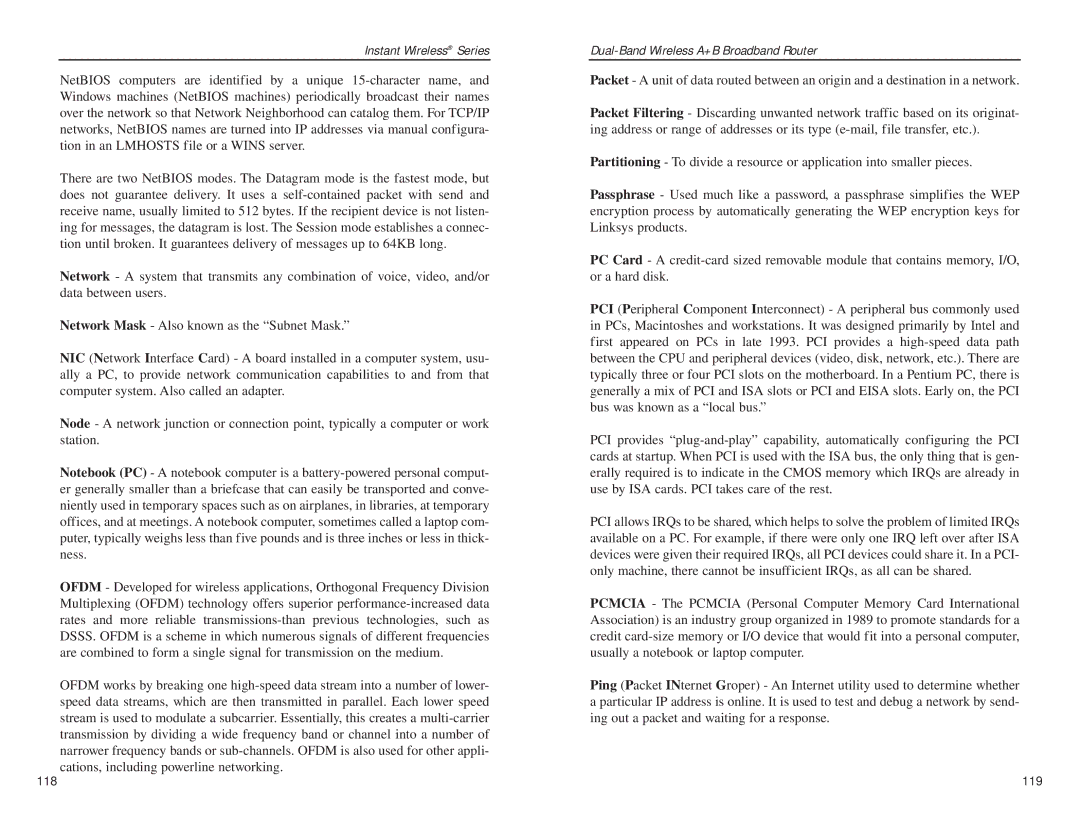Instant Wireless® Series
NetBIOS computers are identified by a unique 15-character name, and Windows machines (NetBIOS machines) periodically broadcast their names over the network so that Network Neighborhood can catalog them. For TCP/IP networks, NetBIOS names are turned into IP addresses via manual configura- tion in an LMHOSTS file or a WINS server.
There are two NetBIOS modes. The Datagram mode is the fastest mode, but does not guarantee delivery. It uses a self-contained packet with send and receive name, usually limited to 512 bytes. If the recipient device is not listen- ing for messages, the datagram is lost. The Session mode establishes a connec- tion until broken. It guarantees delivery of messages up to 64KB long.
Network - A system that transmits any combination of voice, video, and/or data between users.
Network Mask - Also known as the “Subnet Mask.”
NIC (Network Interface Card) - A board installed in a computer system, usu- ally a PC, to provide network communication capabilities to and from that computer system. Also called an adapter.
Node - A network junction or connection point, typically a computer or work station.
Notebook (PC) - A notebook computer is a battery-powered personal comput- er generally smaller than a briefcase that can easily be transported and conve- niently used in temporary spaces such as on airplanes, in libraries, at temporary offices, and at meetings. A notebook computer, sometimes called a laptop com- puter, typically weighs less than five pounds and is three inches or less in thick- ness.
OFDM - Developed for wireless applications, Orthogonal Frequency Division Multiplexing (OFDM) technology offers superior performance-increased data rates and more reliable transmissions-than previous technologies, such as DSSS. OFDM is a scheme in which numerous signals of different frequencies are combined to form a single signal for transmission on the medium.
OFDM works by breaking one high-speed data stream into a number of lower- speed data streams, which are then transmitted in parallel. Each lower speed stream is used to modulate a subcarrier. Essentially, this creates a multi-carrier transmission by dividing a wide frequency band or channel into a number of narrower frequency bands or sub-channels. OFDM is also used for other appli- cations, including powerline networking.
Dual-Band Wireless A+B Broadband Router
Packet - A unit of data routed between an origin and a destination in a network.
Packet Filtering - Discarding unwanted network traffic based on its originat- ing address or range of addresses or its type (e-mail, file transfer, etc.).
Partitioning - To divide a resource or application into smaller pieces.
Passphrase - Used much like a password, a passphrase simplifies the WEP encryption process by automatically generating the WEP encryption keys for Linksys products.
PC Card - A credit-card sized removable module that contains memory, I/O, or a hard disk.
PCI (Peripheral Component Interconnect) - A peripheral bus commonly used in PCs, Macintoshes and workstations. It was designed primarily by Intel and first appeared on PCs in late 1993. PCI provides a high-speed data path between the CPU and peripheral devices (video, disk, network, etc.). There are typically three or four PCI slots on the motherboard. In a Pentium PC, there is generally a mix of PCI and ISA slots or PCI and EISA slots. Early on, the PCI bus was known as a “local bus.”
PCI provides “plug-and-play” capability, automatically configuring the PCI cards at startup. When PCI is used with the ISA bus, the only thing that is gen- erally required is to indicate in the CMOS memory which IRQs are already in use by ISA cards. PCI takes care of the rest.
PCI allows IRQs to be shared, which helps to solve the problem of limited IRQs available on a PC. For example, if there were only one IRQ left over after ISA devices were given their required IRQs, all PCI devices could share it. In a PCI- only machine, there cannot be insufficient IRQs, as all can be shared.
PCMCIA - The PCMCIA (Personal Computer Memory Card International Association) is an industry group organized in 1989 to promote standards for a credit card-size memory or I/O device that would fit into a personal computer, usually a notebook or laptop computer.
Ping (Packet INternet Groper) - An Internet utility used to determine whether a particular IP address is online. It is used to test and debug a network by send- ing out a packet and waiting for a response.
